 W
WThe angon was a type of javelin used during the Early Middle Ages by the Franks and other Germanic peoples, including the Anglo-Saxons. It was similar to, and probably derived from, the pilum used by the Roman army and had a barbed head and long narrow socket or shank made of iron mounted on a wooden haft.
 W
WA bident is a two-pronged implement resembling a pitchfork. In classical mythology, the bident is a weapon associated with Hades (Pluto), the ruler of the underworld. Likewise, the three-pronged trident is the implement of his brother Poseidon (Neptune), god of the seas and earthquakes, and the lightning bolt, which superficially looks as if it has one prong, is a symbol of Zeus.
 W
WA blowgun is a simple ranged weapon consisting of a long narrow tube for shooting light projectiles such as darts. It operates by having the projectile placed inside the pipe and using the force created by forced exhalation ("blow") to pneumatically propel the projectile. The propulsive power is limited by the strength of the user's respiratory muscles and the vital capacity of their lungs.
 W
WA bolas is a type of throwing weapon made of weights on the ends of interconnected cords, used to capture animals by entangling their legs. Bolas were most famously used by the gauchos, but have been found in excavations of Pre-Columbian settlements, especially in Patagonia, where indigenous peoples used them to catch 200-pound guanaco and ñandú (birds). The Mapuche and the Inca army used them in battle. Researchers have also found bolas in North America at the Calico Early Man Site.
 W
WThe bow and arrow is a ranged weapon system consisting of an elastic launching device (bow) and long-shafted projectiles (arrows).
 W
WA burning glass or burning lens is a large convex lens that can concentrate the sun's rays onto a small area, heating up the area and thus resulting in ignition of the exposed surface. Burning mirrors achieve a similar effect by using reflecting surfaces to focus the light. They were used in 18th-century chemical studies for burning materials in closed glass vessels where the products of combustion could be trapped for analysis. The burning glass was a useful contrivance in the days before electrical ignition was easily achieved.
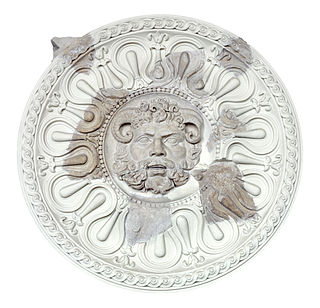 W
WIn the military of classical antiquity, a clipeus was a large shield worn by the Greek hoplites and Romans as a piece of defensive armor, which they carried upon the arm, to protect them from the blows of their enemies. It was round in shape and in the middle was a bolt of iron, or of some other metal, with a sharp point. The clipeus was more-or-less identical to the earlier aspis.
 W
WA crossbow is a ranged weapon using an elastic launching device similar to a bow; it consists of a bow-like assembly called a prod, mounted horizontally on a main frame called a tiller, which is hand-held in a similar fashion to the stock of a long gun. Crossbows shoot arrow-like projectiles called bolts or quarrels. A person who shoots crossbow is called a crossbowman or an arbalist.
 W
WThe dagger-axe is a type of pole weapon that was in use from the Shang dynasty until the Han dynasty in China. It consists of a dagger-shaped blade, mounted by its tang to a perpendicular wooden shaft. The earliest dagger-axe blades were made of stone. Later versions used bronze. Jade versions were also made for ceremonial use. There is a variant type with a divided two-part head, consisting of the usual straight blade and a scythe-like blade.
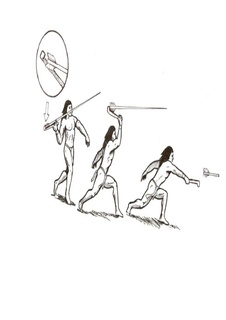 W
WDarts are missile weapons, designed to fly such that a sharp, often weighted point will strike first. They can be distinguished from javelins by fletching and a shaft that is shorter and/or more flexible, and from arrows by the fact that they are not of the right length to use with a normal bow.
 W
WEarly thermal weapons were used in warfare during the classical and medieval periods using heat or burning action to destroy or damage enemy personnel, fortifications or territories.
 W
WAn eku is an ancient weapon of Okinawan kobudō that originated from an oar, approximately 160 cm in length. According to myth, the oar was traditionally adapted for use as a weapon of self-defense by fishermen against foes armed with more conventional weapons. When the Japanese had conquered Okinawa, their old officers taught commoners weapons use as a first line of defense against a possible Chinese invasion. Since quality weapons were expensive, the civilians had to use what equipment they had; the Ryukyu oar came to be used in place of the naginata.
 W
WThe falx was a weapon with a curved blade that was sharp on the inside edge used by the Thracians and Dacians – and, later, a siege hook used by the Romans.
 W
WA gun is a long Chinese staff weapon used in Chinese martial arts. It is known as one of the four major weapons, along with the qiang (spear), dao (sabre), and the jian. It is called, in this group, "The Grandfather of all Weapons". In Vietnam, the gun is known as Côn in Vietnamese martial arts.
 W
WThe harpē (ἅρπη) was a type of sword or sickle; a sword with a sickle protrusion along one edge near the tip of the blade. The harpe is mentioned in Greek and Roman sources, and almost always in mythological contexts.
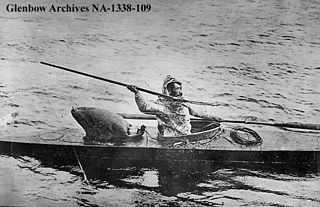 W
WA harpoon is a long spear-like instrument used in fishing, whaling, sealing, and other marine hunting to catch large fish or marine mammals such as whales. It accomplishes this task by impaling the target animal and securing it with barb or toggling claws, allowing the fishermen to use a rope or chain attached to the projectile to catch the animal. A harpoon can also be used as a weapon.
 W
WIllyrian weaponry played an important role in the makeup of Illyrian armies and in conflicts involving the Illyrians. Of all the ancients sources the most important and abundant writings are those of Ennius, a Roman poet of Messapian origin. Weapons of all sorts were also placed intact in the graves of Illyrian warriors and provide a detailed picture for archaeologists on the distribution and development of Illyrian weaponry.
 W
WInuit weapons were primarily hunting tools which served a dual purpose as weapons, whether against other Inuit groups or against their traditional enemies, the Chipewyan, Tłı̨chǫ (Dogrib) Dene, and Cree.
 W
WA javelin is a light spear designed primarily to be thrown, historically as a ranged weapon, but today predominantly for sport. The javelin is almost always thrown by hand, unlike the bow and arrow and slingshot, which shoot projectiles from a mechanism. However, devices do exist to assist the javelin thrower in achieving greater distance, generally called spear-throwers.
 W
WThe Mammoth spear thrower is a spear thrower in the form of a mammoth, discovered at the "Montastruc rock shelter" in Bruniquel, France. It is from the late Magdalenian period and around 12,500 years old. It now forms part of the Christy Collection in the British Museum, and is normally on display in Room 2. Between 7 February – 26 May 2013 it was displayed in the exhibition at the British Museum Ice Age Art: Arrival of the Modern Mind.
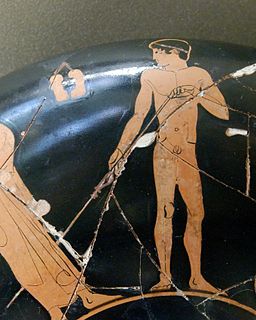 W
WThe mesangylon was a javelin with a strap for throwing it by. Its name is attested, among others, in the works of Euripides, Polybius and Arrian. It is one of the weapons used in Alexander's experimental phalanx
 W
WThe meteor hammer, often referred to simply as meteor, is an ancient Chinese weapon, consisting at its most basic level of two weights connected by a rope or chain. One of the flexible or "soft" weapons, it is referred to by many different names worldwide, dependent upon region, construction and intended use. Other names in use include dai chui, flying hammer, or dragon's fist. It belongs to the broader classes of flail and chain weapons.
 W
WParashu is the Sanskrit word for battle-axe which can be wielded with one or both hands.
 W
WThe rhomphaia was a close-combat bladed weapon used by the Thracians as early as 350-400 BC. Rhomphaias were weapons with a straight or slightly curved single-edged blade attached to a pole, which in most cases was considerably shorter than the blade. Although the rhomphaia was similar to the falx, most archaeological evidence suggests that rhomphaias were forged with straight or slightly curved blades, presumably to enable their use as both a thrusting and slashing weapon. The blade was constructed of iron and used a triangular cross section to accommodate the single cutting edge with a tang of rectangular cross section. Length varied, but a typical rhomphaia would have a blade of approximately 60–80 cm and a tang of approximately 50 cm. From the length of the tang, it can be presumed that, when attached to the hilt, this portion of the weapon would be of similar length to the blade.
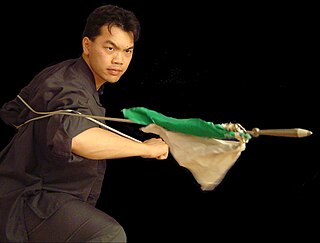 W
WThe rope dart or rope javelin, also known as Jōhyō in Japanese, is one of the flexible weapons in Chinese martial arts. Other weapons in this family include the meteor hammer, flying claws, Fei Tou flying weight, and chain whip. Although the flexible weapons share similar movements, each weapon has its own specific techniques.
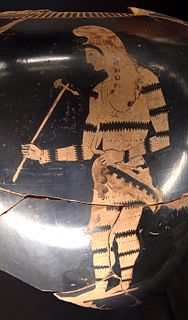 W
WThe sagaris is an ancient Iranian shafted weapon used by the horse-riding ancient Saka and Scythian peoples of the great Eurasian steppe. It was used also by Western and Central Asian peoples: the Medes, Persians, Parthians, Indo-Saka, Kushans, Mossynoeci, and others living within the milieu of Iranian peoples. According to Aristarchus of Samothrace, the legendary Amazons used the sagaris, as well. In The Histories, Herodotus attributes the sagaris to the Sacae Scythians in the army-list of Xerxes the Great.
 W
WThe sarisa or sarissa was a long spear or pike about 4–6 metres (13–20 ft) in length. It was introduced by Philip II of Macedon and was used in his Macedonian phalanxes as a replacement for the earlier dory, which was considerably shorter. These longer spears improved the strength of the phalanx by extending the rows of overlapping weapons projecting towards the enemy, and the word remained in use throughout the Byzantine years to sometimes describe the long spears of their own infantry.
 W
WA shield is a piece of personal armour held in the hand, which may or may not be strapped to the wrist or forearm. Shields are used to intercept specific attacks, whether from close-ranged weaponry or projectiles such as arrows, by means of active blocks, as well as to provide passive protection by closing one or more lines of engagement during combat.
 W
WThe sica was a short sword or large dagger of ancient Thracians, Dacians and Illyrians, used in Ancient Rome too, originating in the Halstatt culture. It was originally depicted as a curved sword and many examples have been found in what are today Albania, Bosnia, Bulgaria, Serbia and Romania. It is also depicted on Trajan's Column; notably the Dacian king Decebalus is depicted committing suicide with one.
 W
WThe spear or lance, together with the bow, the sword, the seax and the shield, was the main equipment of the Germanic warriors during the Migration Period and the Early Middle Ages.
 W
WThe Spear of Fuchai is the spear of King Fuchai of Wu, the archrival of King Goujian of Yue. It was unearthed in Jiangling, Hubei in November 1983. The script on it is bird-worm seal script, a variant of seal script that was commonly used in the southern states such as Wu and Yue. The inscription mirrors the text of King Goujian's Sword, except changing the name of the owner and type of weapon. In this case, the text reads, "吴王夫差自作用矛" or "King Fuchai of Wu made for his personal use, this spear."
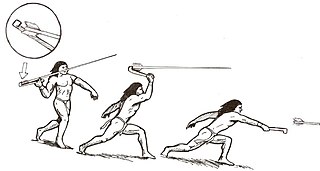 W
WA spear-thrower, spear-throwing lever or atlatl is a tool that uses leverage to achieve greater velocity in dart or javelin-throwing, and includes a bearing surface which allows the user to store energy during the throw.
 W
WThe surujin or suruchin is one of the traditional weapons of Okinawan Kobudo. It comprises a 2–3 metre long rope with a weight tied to each end. Historically this weapon is very prevalent and can be found attached to a weapon or used separately. It is a weapon designed for warfare.
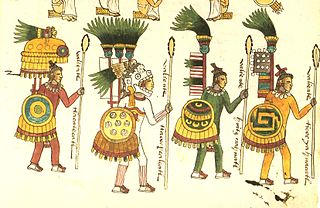 W
WThe tepoztopilli [tepostoːˈpiːlːi] was a common front-line weapon of the Aztec military. The tepoztopilli was a pole-arm, and to judge from depictions in various Aztec codices it was roughly the height of a man, although historian John Pohl indicates that the weapon used between the 12th and 14th century was made in sizes from 3 feet to 7 feet in length. The wedge-shaped wooden head, about twice the length of the users' palm or shorter, was edged with razor-sharp obsidian blades which were deeply set in grooves carved into the head. They were cemented in place with bitumen or plant resin as an adhesive. This made the tepoztopilli vaguely similar to the macuahuitl or "macana", however it had a much smaller cutting edge and a longer handle. The greater length gave the weapon a superior reach, allowing the user to stand behind a line of more experienced warriors and then "shove or jab the weapon" into an adversary.
 W
WThe throwing stick or throwing club is a wooden rod with either a pointed tip or a spearhead attached to one end, intended for use as a weapon. A throwing stick can be either straight or roughly boomerang-shaped, and is much shorter than the javelin. It became obsolete as slings and bows became more prevalent, except on the Australian continent, where the native people continued refining the basic design. Throwing sticks shaped like returning boomerangs are designed to fly straight to a target at long ranges, their surfaces acting as airfoils. When tuned correctly they do not exhibit curved flight, but rather they fly on an extended straight flight path. Straight flight ranges greater than 100 meters have been reported by historical sources as well as in recent research.
 W
WThe toggling harpoon is an ancient weapon and tool used in whaling to impale a whale when thrown. Unlike earlier harpoon versions which had only one point, a toggling harpoon has a two-part point. One half of the point is firmly attached to the thrusting base, while the other half of the point is fitted over this first point like a cap and attached to the rest of the point with sinew or another string-like material. When the harpoon is thrust into an animal, the top half of the point detaches and twists horizontally into the animal under the skin, allowing hunters to haul the animal to ship or shore. This harpoon technology lodges the toggling head of the harpoon underneath both the animal's skin and blubber, and instead lodges the point in the muscle, which also prevents the harpoon slipping out.
 W
WA tomahawk is a type of single-handed ax native to the many Indigenous peoples and nations of North America, traditionally resembling a hatchet with a straight shaft. The term came into the English language in the 17th century as an adaptation of the Powhatan word.
 W
WA trident is a three-pronged spear. It is used for spear fishing and historically as a polearm.
 W
WWind-and-fire wheels are mêlée weapons, wielded as a pair, associated with Chinese martial arts such as baguazhang and taijiquan. Visually, they are similar to chakrams, although unlike chakrams they are not throwing weapons.
 W
WThe xyston (Ancient Greek: ξυστόν "spear, javelin; pointed or spiked stick, goad ", a derivative of the verb ξύω "scrape, shave", was a type of a long thrusting spear in ancient Greece. It measured about 3.5–4.25 meters long and was probably held by the cavalryman with both hands, although the depiction of Alexander the Great's xyston on the Alexander Mosaic in Pompeii, suggests that it could also be used single handed. It had a wooden shaft and a spear-point at both ends. Possible reasons for the secondary spear-tip were that it acted partly as a counterweight and also served as a backup in case the xyston was broken in action. The xyston is usually mentioned in context with the hetairoi, the cavalry forces of ancient Macedon. After Alexander the Great's death, the hetairoi were named xystophoroi because of their use of the xyston lance. In his Greek-written Bellum Judaicum, the Jewish historian Flavius Josephus uses the term xyston to describe the Roman throwing javelin, the pilum.